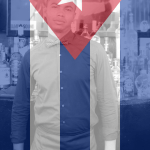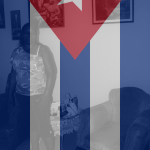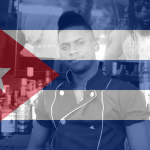In less than 30 days, I will touch down on US tarmac. Once again I will walk the streets of Brooklyn, the borough of my birth and upbringing, if only for a few months before completing my final year at Amherst. Time has flown during my undergrad years including this study abroad experience. And yet I’ve spent the majority of my time here in Cuba reflecting on how I choose to spend my time. I am a culture child – one who raised on mommy’s Jamaican food and distinct dialect, my neighborhood’s diverse Caribbean-American lifestyle, from the music to the fashion, my childhood block’s street games and life lessons taught in riddles and rhymes, on school stages in talent shows, in church pageants and presentations. My sense of being has always been defined by the rich culture that has not only influenced my views but literally has given me the ability to see the world. Culture is the mother of my senses, the father of my footsteps, the village that has raised me. So as a child literally raised on culture, my culture shock arose here in Cuba when I seemed to be searching for distinct Cuban cultures and couldn’t really put my finger on any of them.
My national identity as an American coupled with my racial and ethnic identity as a Black woman of Jamaican descent sometimes blocked people’s ability to connect with me. Making mention of the land of my birth served as a wall between me and Cubans at times, a bloqueo of any true genuine exchange. But my unique hair curl pattern and skin color had a way of breaking down these walls. The story of how someone who looked like me could live in the states and choose this country to receive an education intrigued many. My ability to exceed their expectations of “extranjeros“- speaking solely in Spanish and little by little understanding their cubano parlance enough to speak some of it myself – formed enough of a bridge between my world and theirs.
The common talk of Cuban culture as “rice and beans, old cars, and baseball” never truly satisfied my palate. I did not come here to accept a tour guide’s simplification of the Cuban reality. Instead, I challenged myself to see The Cuban’s Cuba. I sat and spoke with the owner’s of my favorite lunch spot about why arroz congris was so popular and shared with him my aunt’s secret ingredient of coconut milk. I’ve ridden in maquinas up and down Havana and in other provinces, chatting up the drivers about everything from reggaetón and rumba to gender roles and the embargo. I’ve played pelota with our host families and neighborhood kids, and watched baseball games with Cubans both on TV and in the stadium (¡Vayan los Industriales!)
This is how I have always spent my time – immersing myself in cultures outside of my own while still sharing mine ever so proudly. At Amherst, I have unapologetically let my guard down about the person I am and have encouraged others to do the same with me. And that yearning for cultural exchange is what I carried with me on my trip here to Havana. Because, culture is built on vulnerability. The building up and tearing down of walls within yourself in an effort to let the true you be. At least that is my narrative of my culture – a culture of oppressed people that have made it out through clinging to their constant recreations and redefinitions of themselves and their culture. So when I reached Havana and saw people that looked like me that may have their own hidden cultures to let free, I was disheartened and often times frustrated by their inability to do so with me.
I must admit that at one point in my time here, I was convinced that Cuba had no culture. This was in part because I was hearing one narrative in the classroom but experiencing an entirely different one in my daily encounters. For example, in my Estudios Afrocaribeños class, I was taught that the most prominent Afro-Cuban religion had two interchangeable names: Regla de Ocha and Santería, however the latter was used more frequently in scholarly readings than the former. I only came to understand why the former was so hidden by attending one of the religious ceremonies myself – the “africanity” of Regla de Ocha over time has been mixed with the national religion of Catholicism in order to preserve its presence in society as Santería. This is just one example of many proving that Cuban culture is one of being concealed. The hidden truths have become the truths themselves, and this culture child could not allow herself to be content with just that.
One thing I did know from my personal life and good ole BLST-300: Research Methods in Black Studies, is that people like to talk and talk about themselves. So from dissecting what Cubans said about themselves and their experiences I could take what was said and what wasn’t, the umms, ahhs, pauses and repetitions, and understand the crux of how they felt in the context of their society. Conversations in Cuba are not usually centered on the impact of their politics on daily life, the importance of family given the social revolution, and the way in which race and skin color play a role in one’s opportunity despite the great “mezcla de razas”. But somehow I was able to get to these cores with the Cubans I met by asking about the music they liked, the hairstyles they donned, the jewelry they wore, the jobs that they had or didn’t have, their parents who bore them and the children whom they bore. Rather than introducing myself from a space of privilege, I met Cubans on their terms – knowing all too well of the times I have been placed in that position in classrooms, on teams and in organizations, where I was the disadvantaged one. My inability to play the typical role as the patriarchal outsider allowed me to step in and see my brothers and sisters of Cuba as just that – new members of my extended international family. So as I’ve read Fernando Ortiz’s essay multiple times comparing the Cuban society to that of their national stew, el ajiaco, I’ve found my true sustenance from the unique ingredients that create Cubans’s equivalent to our melting pot.
And that’s all a culture child needs – true sustenance.





